Remembering the working west coast
From Camp to Camp, from Dock to Dock: The Work of Doug Harrison, The BC Coast in My Eyes
by Doug Harrison
Gabriola Island: Doug Harrison (workingwestcoast@shaw.ca), 2023
Spiral-bound. $39.95
Reviewed by Phyllis Reeve
*
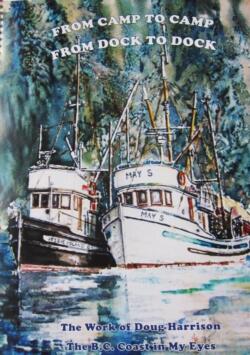
“It is my intent to use the images to generate stories. Stories about people who had skills that are now lost with the passage of time.” Doug Harrison uses his talent for painting to tell a story that needs to be told by someone who has been part of the story – and remembered by all of us who care about Canada’s west coast. He presents his book as “a story of events I witnessed in a lifetime of living and working in the logging camps and workboats on the BC Coast.” When he makes the disclaimer that “none of these images can be considered historical fact. They simply tell a story!” I want to argue that the images are at the very least the products of informed imagination. But they are more than that; looking at them, we know this is how things were.

Doug’s own story begins in a logging camp on what his mother claims was a dark and stormy night, but he suspects she might have made this up because it “makes a good story.” I doubt she had to make up anything. She was born on a Union Steamship between Pender Harbour and the First Narrows, grew up to become a school marm at Coombs (“where the goats are on the roof”), and married a logger/ fireman/ train engineer/ mechanic from the Alberni Valley. Doug attended UBC (“Anybody got accepted in those days.”) funded by summer jobs which also served as auxiliary education. He worked for Macmillan Bloedel during the “glory days” and “ran all the big camps on the east coast of Vancouver Island” until he was promoted from hands-on work in the bush to a political position at a desk. He had noticed the deterioration to “a complete disconnect between ourselves, the workers on site, and the people living down south in the Lower Mainland.” Now he was on the wrong side of the disconnect and logging wasn’t fun anymore. At that point he retired to Gabriola Island with a view of False Narrows, Mudge Island and Vancouver Island in the near distance. Then he set about painting his stories.
Harrison does not consider himself a “true artist” – whatever that may be. He relies not on photographs but on memory, imagination and a detailed knowledge of how things work. “I can’t even paint a landscape without putting a boat, train or logging truck in the foreground,” he says, as though that were a problem.
He presents the pictures in separate but overlapping sections corresponding to chapters in his story or items in his obsession with the detailed history of the working coast. He does not number the sections, but I do for my and your convenience.
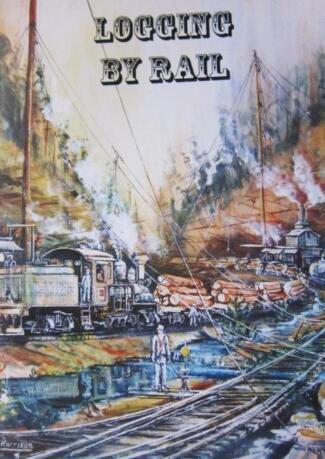
1. LOGGING BY RAIL. “Christmas at Port Alberni Station” – “the old truck is an International KB-2 1949. My dad bought it in 1953 and drove it to work for the next 18 years.”
2. LOGGING. “It was a good life, but it could not be sustained.”
3. QUEEN CHARLOTTES. Haida Gwaii – “We called the Islands the “Charlottes” in our day.” Doug was hired in 1973 to supervise Falling, Bucking, Yarding, Loading, Booming, and Barge Loading. “I made it my job to keep people alive the best I could and get wood in the water and out onto the barges.”
4. FISHING. While waiting for fisheries to open there was “lots of time for stories”. The painting “On the Beach” celebrates little fishing boats “constructed from material on hand – Western Red Cedar, Douglas Fir, Yellow Cedar – with steamed Oak ribs and Purple Heart for trim. Most of these boats are gone now. Part of history, just like the men that fished them. Only the stories remain!” “On the Beach – Alert Bay” pays tribute to Japanese boatbuilders and fishermen.
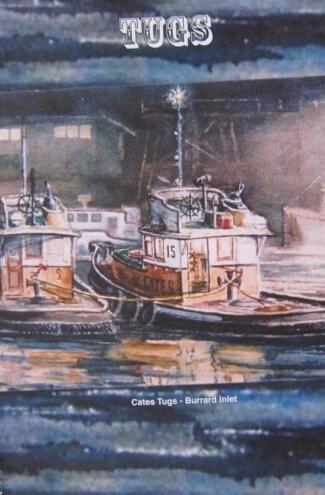
5. TUGS. ” I got to meet many towboat men, heard their stories and became fascinated with them.”) Here is an opportunity to relate the narrative of The Grimsby Trawlers from 1912-41, and, while painting “Charlotte Wood- Alberni Inlet” to recall his own involvement in the story: “I was Superintendent of the Central Log sorting ground in Alberni in the early 1970s…. An experience I would like to forget.”
6. SAILING VESSELS. Paintings of the tall ships Pacific Grace and Pacific Swift acknowledge the work of the Sail and Life Training Society (SALTS). Thinking historically, he paints “Gabriola History – 1791 to Present,” a palimpsest imagining of past, present, and future vessels with realistic mountains and visionary clouds.
7. E&N RAILROAD [Esquimalt & Nanaimo]. He knows the details and specifications of the trains – as of boats and automobiles. “Parksville Station – 1915” shows the scene five years after his parents moved to the area. “The locomotive shown is a D4G ten wheeler, a state of the art high speed passenger unit at the time.” The locomotive in “Christmas on the E&N” is “a D10 – ten wheeler, the largest and last type to be utilized on the railroad before the steamers were replaced in 1949.”
8. COASTAL STEAMERS marvels at the skills of the Master Mariners, with his visions of the Princess Marguerite off Entrance Island and the Princess Maquinna with detailed comparison of the upper decks versus the holds (where the best stories were told). The “North Atlantic Convoy” is his “creation of a scene that could have happened on the day [he] was born in mid 1943.”
9. AIRCRAFT features the DH-2 Beaver Bush Plane “Flying for more than seventy years and still going strong,” and several firefighting and otherwise adventurous planes. The “Silva Bay Bomber” is in the Gabriola section.
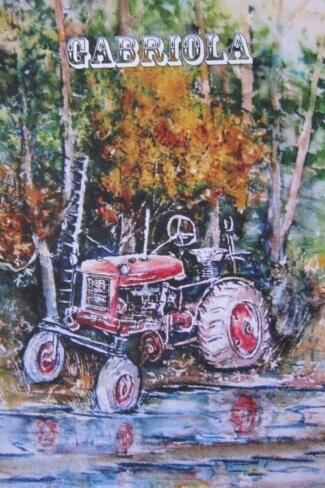
10. GABRIOLA is devoted to his home island. Since it is also my home, I can attest to the accuracy of the images.
11. FAMILY proves that he can and does paint portraits.
12. MISCELLANEOUS shows Granville Street in 1928, Ladysmith on fire in the 1940s, an unwelcome racoon, and a mermaid (he tells us these were works of imagination).
On the back cover a steamship meets a seiner, “a scene typical of the 1930s.”
Doug Harrison’s paintings reveal a nostalgia for the passing of the old logging days, but without unrealistic sentiment, and with a determination to honour those old days, and the even older days, the glory days of the people who were here first.
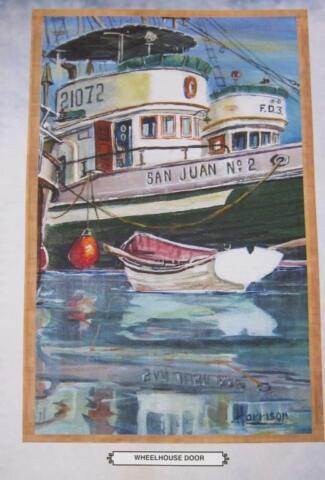
As for whether or not he is a “true artist” – the painting Wheelhouse Door is an especially strong close-up which suggests Doug is more than capable of other more fashionable styles, but those would not fit his purpose. Perhaps they would clash with his storytelling and constitute another “promotion” of the sort he does not want?
I recognised several vessels from a very different book. The four-masted steel barque Pamir, the tea clipper Thermopylae and the tugboat Lorne appear in Keith McLaren’s Light on the Water; early photography of coastal British Columbia (Douglas & McIntyre, 1998). The photographs possess a serenity which is almost elegiac. Doug’s paintings are all action and, he would insist, all imagination. Yet it is a paradox: which medium is more “real” and which is more true to life?
That the book is not smoothly edited is all to the good – like following him around while he shows his pictures and spins a yarn about each one. Having said that, I do look forward to the second edition, with sharper proofreading and such formalities as an ISBN to facilitate searching and ordering by the individuals, libraries, and booksellers who need to find this book.
[Editor’s note: Doug Harrison’s book is available at Page’s Marina, Gabriola Museum, Alberni Valley Museum, Nanaimo Museum, or the BC Forest Discovery Centre.]
*
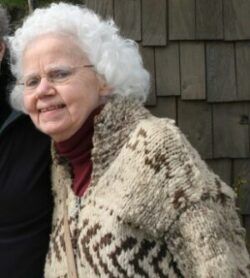
Phyllis Parham Reeve was born in Fiji, grew up in Quebec, and has lived most of her life in British Columbia. Her most recent publication, in Dorchester Review #25 (Spring/ Summer 2023) revisits the history of pre-colonial Fiji in the writings of her paternal grandmother Richenda Parham. Editor’s note: Phyllis Reeve has recently reviewed books by Dave and Rosemary Neads, Robert G. Allan, Mother Tongue Publishing, Lara Campbell, Michael Dawson, & Catherine Gidney, Donald Lawrence, Josephine Mills, & Emily Dundas Oke, and Iain Lawrence for The British Columbia Review.
*
The British Columbia Review
Interim Editors, 2023-24: Trevor Marc Hughes (non-fiction), Brett Josef Grubisic (fiction)
Publisher: Richard Mackie
Formerly The Ormsby Review, The British Columbia Review is an on-line book review and journal service for BC writers and readers. The Advisory Board now consists of Jean Barman, Wade Davis, Robin Fisher, Barry Gough, Hugh Johnston, Kathy Mezei, Patricia Roy, Maria Tippett, and Graeme Wynn. Provincial Government Patron (since September 2018): Creative BC. Honorary Patron: Yosef Wosk. Scholarly Patron: SFU Graduate Liberal Studies. The British Columbia Review was founded in 2016 by Richard Mackie and Alan Twigg.
“Only connect.” – E.M. Forster





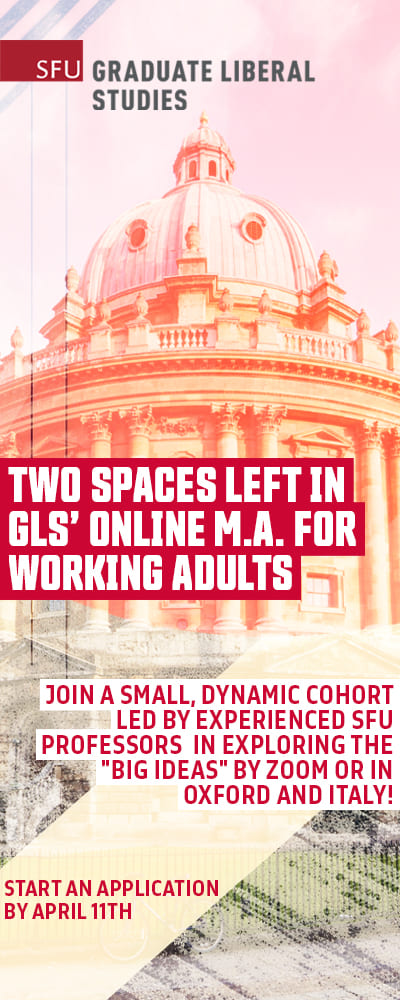

























5 comments on “Remembering the working west coast”
Great review! Thanks, Phyllis Reeve!